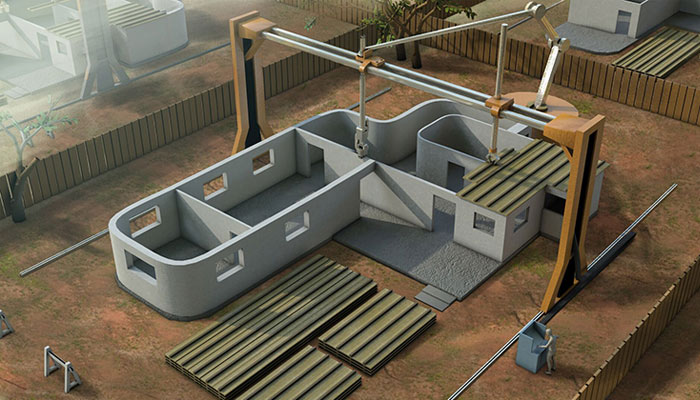The Advancement of Building with 3D Printing Innovations
As we progress through the evolving landscape of engineering, one breakthrough stands notably in the sector of construction: 3D printing. This remarkable approach is transforming the method developments and structures are conceived and built, bringing forth a new age of efficiency, eco-friendliness, and innovation. Reshaping Construction: One Layer at a Time The implementation of 3D manufacturing in infrastructure delivers numerous revolutionary gains. Primary among these is the drastic minimization in substance excess. Conventional construction approaches usually lead in considerable excess materials that add to environmental pollution. In contrast, 3D manufacturing employs a precise stratum-by-stratum approach, using only the necessary portion of material and thus reducing excess greatly. Another significant benefit is the dramatic decrease in development duration. Developments that conventionally require extended durations can be finalized in a segment of the timeline with 3D manufacturing systems. This time reduction is due to the self-operating mechanism of 3D printers that can function continuously without worker involvement, greatly minimizing complete development timelines. Moreover, 3D manufacturing introduces possibilities for constructing complex, personalized designs at no extra expense. The versatility of 3D devices enables for detailed patterns and shapes to be developed that would either be extremely costly or inconceivable to attain with traditional infrastructure methods. This feature not only improves architectural visual appeal but also allows designers to maximize layouts for enhanced functionality and longevity.  Reducing Expenses and Enhancing Accessibility Budget cutting is yet another significant advantage delivered by 3D manufacturing in building. By cutting labor expenses and decreasing the timeline needed to complete undertakings, the overall cost linked to constructing frameworks is reduced. Furthermore, cheap 3D manufacturing devices are growing more attainable, putting this innovation attainable for smaller companies and independent creators eager to experiment with its capabilities. The cost-effectiveness of these devices also paves the way for innovation in related sectors such as garment manufacturing. While primarily acknowledged in building industries, the scope of 3D fabrication expands into various areas including fashion. Here, creators explore with 3D fabricated garments, expanding design constraints and reshaping material handling while utilizing low production expenses. A Sustainable Future Fueled by Technology Eco-friendliness is another foundation of this technology’s attraction in the construction industry. 3D manufacturing encourages a sustainable strategy to building by minimizing material surplus and power expenditure. Furthermore, it enables the use of green substances like repurposed synthetics or hybrid mixtures, which additionally lowers the environmental effect of this historically heavy-polluting sector. The worldwide transition towards eco-conscious approaches discovers a strong ally in 3D manufacturing technologies, potentially transforming how structural regulations and standards are formulated in the future. By implementing these cutting-edge techniques, the infrastructure industry moves towards reaching eco-friendly business strategies. Turning Visions to Existence Imagine neighborhood hubs in disadvantaged regions being built within a short time to meet urgent requirements or visionaries designing masterpieces reminiscent of organic formations that merge effortlessly into their surroundings – such situations are not only theoretical but are quickly becoming achievable through 3D printing. While these breakthroughs indicate just the beginning, they hint at a future where building integrates perfectly with both cultural ambitions and environmental stewardship. If we continue on this trajectory, construction will not only mean the physical formation of structures but also signify a commitment to forward-thinking mindsets and responsible living. Merging creativity with practicality, 3D fabrication stands poised to transform our tangible world in forms we are just beginning to grasp. Through ongoing progress and an acceptance of these futuristic approaches, our constructed spaces will certainly morph into reflections of societal brilliance powered by the exactness and endless potential of 3D manufacturing. To get more information about may in soi nhuacheck out our webpage
Reducing Expenses and Enhancing Accessibility Budget cutting is yet another significant advantage delivered by 3D manufacturing in building. By cutting labor expenses and decreasing the timeline needed to complete undertakings, the overall cost linked to constructing frameworks is reduced. Furthermore, cheap 3D manufacturing devices are growing more attainable, putting this innovation attainable for smaller companies and independent creators eager to experiment with its capabilities. The cost-effectiveness of these devices also paves the way for innovation in related sectors such as garment manufacturing. While primarily acknowledged in building industries, the scope of 3D fabrication expands into various areas including fashion. Here, creators explore with 3D fabricated garments, expanding design constraints and reshaping material handling while utilizing low production expenses. A Sustainable Future Fueled by Technology Eco-friendliness is another foundation of this technology’s attraction in the construction industry. 3D manufacturing encourages a sustainable strategy to building by minimizing material surplus and power expenditure. Furthermore, it enables the use of green substances like repurposed synthetics or hybrid mixtures, which additionally lowers the environmental effect of this historically heavy-polluting sector. The worldwide transition towards eco-conscious approaches discovers a strong ally in 3D manufacturing technologies, potentially transforming how structural regulations and standards are formulated in the future. By implementing these cutting-edge techniques, the infrastructure industry moves towards reaching eco-friendly business strategies. Turning Visions to Existence Imagine neighborhood hubs in disadvantaged regions being built within a short time to meet urgent requirements or visionaries designing masterpieces reminiscent of organic formations that merge effortlessly into their surroundings – such situations are not only theoretical but are quickly becoming achievable through 3D printing. While these breakthroughs indicate just the beginning, they hint at a future where building integrates perfectly with both cultural ambitions and environmental stewardship. If we continue on this trajectory, construction will not only mean the physical formation of structures but also signify a commitment to forward-thinking mindsets and responsible living. Merging creativity with practicality, 3D fabrication stands poised to transform our tangible world in forms we are just beginning to grasp. Through ongoing progress and an acceptance of these futuristic approaches, our constructed spaces will certainly morph into reflections of societal brilliance powered by the exactness and endless potential of 3D manufacturing. To get more information about may in soi nhuacheck out our webpage